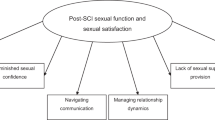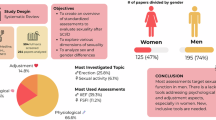Abstract
Study design:
Questionnaire development, validation and completion.
Objectives:
Develop comprehensive survey of sexuality issues including validated self-report versions of the International Spinal Cord Injury male sexual function and female sexual and reproductive function basic data sets (SR-iSCI-sexual function).
Setting:
People with spinal cord damage (SCD) living in the community, Australia from August 2013 to June 2014.
Methods:
An iterative process involving rehabilitation medicine clinicians, a nurse specialising in sexuality issues in SCD and people with SCD who developed a comprehensive survey that included the SR-iSCI-sexual function. Participants recruitment through spinal rehabilitation review clinic and community organisations that support people with SCD.
Results:
Surveys completed by 154 people. Most were male (n=101, 65.6%). Respondents’ median age was 50 years (interquartile range (IQR) 38–58), and they were a median of 10 years (IQR 4–20) after the onset of SCD. Sexual problems unrelated to SCD were reported by 12 (8%) respondents, and 114 (n=75.5%) reported sexual problems because of SCD. Orgasms were much less likely (χ2=13.1, P=0.006) to be normal in males (n=5, 5%) compared with females (n=11, 22%). Males had significantly worse (χ2=26.0, P=0.001) psychogenic genital functioning (normal n=9, 9%) than females (normal n=13, 26%) and worse (χ2=10.8, P=0.013) reflex genital functioning. Normal ejaculation was reported in only three (3%) men. Most (n=26, 52%) women reported reduced or absent menstruation pattern since SCD.
Conclusion:
The SR-iSCI-sexual function provides a useful tool for researchers and clinicians to collect information regarding patient-reported sexual functioning after SCD and to facilitate comparative studies.
Similar content being viewed by others
Log in or create a free account to read this content
Gain free access to this article, as well as selected content from this journal and more on nature.com
or
References
World Health Organisation Defining Sexual Health: Report of a Technical Consultation on Sexual Health 2006.
Shakespeare T . Disabled sexuality: toward rights and recognition. Sex Disabil 2000; 18: 159–166.
Mall S, Swartz L . Sexuality, disability and human rights: strengthening healthcare for disabled people. S Afr Med J 2012; 102: 792–793.
Elliott S . Sexual dysfunction in women with spinal cord injury. In: Lin VW (ed). Spinal Cord Medicine: Principles and Practice. 2nd edn. Demos Medical Publishing: New York, NY. 2010; pp 429–437.
Elliott S . Sexual dysfunction in men with spinal cord injury. In: Lin VW (ed). Spinal Cord Medicine: Principles and Practice 2nd edn. Demos Medical Publishing: New York, NY. 2010; pp 409–428.
Simpson L, Eng J, Hsieh J, Wolfe D . Spinal Cord Injury Rehabilitation Evidence (SCIRE) Research Team. The health and life priorities of individuals with spinal cord injury: a systematic review. J Neurotrauma 2012; 29: 1548–1555.
Anderson K . Targeting recovery: priorities of the spinal cord-injured population. J Neurotrauma 2004; 21: 1371–1383.
New PW, Delafosse V . What to call spinal cord damage not due to trauma? Implications for literature searching. J Spinal Cord Med 2012; 35: 89–95.
Kreuter M, Taft C, Siösteen A, Biering-Sørensen F . Women’s sexual functioning and sex life after spinal cord injury. Spinal Cord 2011; 49: 154–160.
New P, Reeves R, Smith É, Townson A, Eriks-Hoogland I, Gupta A et al. International retrospective comparison of inpatient rehabilitation for patients with spinal cord dysfunction epidemiology and clinical outcomes. Arch Phys Med Rehabil 2015; 96: 1080–1087.
New PW, Simmonds F, Stevermuer T . A population-based study comparing traumatic spinal cord injury and non-traumatic spinal cord injury using a National Rehabilitation Database. Spinal Cord 2011; 49: 397–403.
New PW, Sundararajan V . Incidence of non-traumatic spinal cord injury in Victoria, Australia: a population-based study and literature review. Spinal Cord 2008; 46: 406–411.
Noonan VK, Fingas M, Farry A, Baxter D, Singh A, Fehlings MG et al. The incidence and prevalence of SCI in Canada: a National Perspective. Neuroepidemiology 2012; 38: 219–226.
Alexander M, Biering-Sørensen F, Elliott S, Kreuter M, Sønksen J . International spinal cord injury male sexual function basic data set. Spinal Cord 2011; 49: 795–798.
Alexander M, Biering-Sørensen F, Elliott S, Kreuter M, Sønksen J . International spinal cord injury female sexual and reproductive function basic data set. Spinal Cord 2011; 49: 787–790.
Biering-Sørensen F, Charlifue S, DeVivo M, Noonan V, Post M, Stripling T et al. International spinal cord injury data sets. Spinal Cord 2006; 44: 530–534.
Dillman D, Smyth J, Christian L . Internet, Phone, Mail and Mixed-Mode Surveys: The Tailored Design Method. 4 ed. John Wiley & Sons Inc.: Hoboken, NJ. 2014.
Abramson C, McBride K, Konnyu K, Elliott S . Sexual health outcome measures for individuals with a spinal cord injury: a systematic review. Spinal Cord 2008; 46: 320–324.
DeVivo M, Biering-Sørensen F, Charlifue S, Noonan V, Post M, Stripling T et al. International spinal cord injury core data set. Spinal Cord 2006; 44: 535–540.
New PW, Marshall R . International spinal cord injury data sets for non-traumatic spinal cord injury. Spinal Cord 2014; 52: 123–132.
Charlifue S, Post MW, Biering-Sørensen F, Catz A, Dijkers M, Geyh S et al. International spinal cord injury quality of life Basic Data Set. Spinal Cord 2012; 50: 672–675.
Kalpakjian C, Scelza W, Forchheimer M, Toussaint L . Preliminary reliability and validity of a spinal cord injury secondary conditions scale. J Spinal Cord Med 2007; 30: 131–139.
Taleporos G, McCabe MP . Development and validation of the physical disability sexual and body esteem scale. Sex Disabil 2002; 20: 159–176.
Kreuter M, Sullivan M, Siösteen A . Sexual adjustment after spinal cord injury (SCI) focusing on partner experiences. Paraplegia 1994; 32: 225–235.
Kreuter M, Sullivan M, Siösteen A . Sexual adjustment after spinal cord injury-comparison of partner experiences in pre- and postinjury relationships. Paraplegia 1994; 32: 759–770.
Kreuter M, Sullivan M, Siösteen A . Sexual adjustment and quality of relationships in spinal paraplegia: a controlled study. Arch Phys Med Rehabil 1996; 77: 541–548.
Siösteen A, Lundqvist C, Blomstrand C, Sullivan L, Sullivan IM . Sexual ability, activity, attitudes and satisfaction as part of adjustment in spinal cord-injured subjects. Paraplegia 1990; 28: 285–295.
Lombardi G, Del Popolo G, Macchiarella A, Mencarini M, Celso M . Sexual rehabilitation in women with spinal cord injury: a critical review of the literature. Spinal Cord 2010; 48: 842–29.
Biering-Sørensen F, Sønksen J . Penile erection in men with spinal cord or cauda equina lesions. Semin Neurol 1992; 12: 98–105.
Anderson K, Borisoff J, Johnson R, Stiens S, Elliott S . Long-term effects of spinal cord injury on sexual function in men: implications for neuroplasticity. Spinal Cord 2007; 45: 338–348.
Biering-Sørensen F, Sønksen J . Fertility in men with spinal cord or cauda equina lesions. Semin Neurol 1992; 12: 106–114.
Alexander C, Sipski M, Findley T . Sexual activities, desire, and satisfaction in males pre- and post-spinal cord injury. Arch Sex Behav 1993; 22: 217–228.
Sipski M, Alexander C . Sexual activities, response, and satisfaction in women pre- and post-spinal cord injury. Arch Phys Med Rehabil 1993; 74: 1025–1029.
Anderson K, Borisoff J, Johnson R, Stiens S, Elliott S . Spinal cord injury influences psychogenic as well as physical components of female sexual ability. Spinal Cord 2007; 45: 349–359.
Grulich AE, de Visser RO, Badcock PB, Smith AMA, Heywood W, Richters J et al. Homosexual experience and recent homosexual encounters: the Second Australian Study of Health and Relationships. Sexual Health 2014; 11: 439–450.
Strassberg DS, Lowe K . Volunteer bias in sexuality research. Arch Sex Behav 1995; 24: 369–382.
Acknowledgements
The following people are thanked for their assistance with the development of the SR-iSCI-sexual function data sets: Lynne Panayiotis, Georgina Fiorentino, Mark Hanson, Mike Short, anonymous, anonymous and Vanessa Hamilton (Sexual Health Nurse Consultant, Austin Health, Melbourne, Australia). Merilyn Seddon (Monash University) and the following organisations are thanked for their assistance with distribution of the survey that included the SR-iSCI-sexual function data sets: AQA (Victoria), Spinal Injuries Association (Queensland), Spinal Cord Injuries Australia (New South Wales), Paraplegic-Quadriplegic Association of WA, ParaQuad NSW, Paraplegic and Quadriplegic Association of South Australia, Spinal Cord Injury Network (Australia). We thank all the participants who completed the survey. Dr Daniel E Rohe, Mayo Clinic, Rochester, MN, USA, is thanked for providing helpful suggestions on an earlier draft of the manuscript. Some of the information in the manuscript was presented at the 53rd ISCoS Annual Scientific Meeting, Maastricht, The Netherlands, on 2 September 2014.
Author information
Authors and Affiliations
Corresponding author
Ethics declarations
Competing interests
The authors declare no conflict of interest.
Appendix 1
Appendix 1
Self-report versions of the International Spinal Cord Society male sexual function and female sexual and reproductive function data sets
QUESTIONS IN BOTH MALE AND FEMALE DATA SETS
Do you have any sexual problems or issues unrelated to your spinal cord damage?
__ Yes, please specify ____________________
__ No
__ Unsure
Do you have any sexual problems or issues due to your spinal cord damage?
__ Yes
__ No
__ Unsure
How would you rate your ability to have an orgasm?
__ Normal
__ Reduced/altered
__ Absent
__ Unknown
MALES DATA SET
How would you rate your ability to have psychogenic erections? (A psychogenic erection is an erection that occurs without any physical touching. This may occur if a man thinks of something sexual or sometimes it just happens on its own)?
__ Normal
__ Reduced/altered
__ Absent
__ Unknown
How would you rate your ability to have reflex erections (This is an erection that occurs because of physical stimulation or touch)?
__ Normal
__ Reduced/altered
__ Absent
__ Unknown
How would you rate your ability to ejaculate?
__ Normal
__ Reduced/altered
__ Absent
__ Unknown
FEMALES DATA SET
How would you rate your ability to have psychogenic genital arousal (This is when genital changes and lubrication occur without any physical touching. This may occur if a woman thinks of something sexual or sometimes it just happens on its own)?
__ Normal
__ Reduced/altered
__ Absent
__ Unknown
How would you rate your ability to have reflex genital arousal (This is when genital changes and lubrication occur because of physical stimulation or touch)?
__ Normal
__ Reduced/altered
__ Absent
__ Unknown
How would you rate your current menstruation pattern?
__ Normal
__ Reduced/altered
__ Absent
__ Unknown
Rights and permissions
About this article
Cite this article
New, P., Currie, K. Development of a comprehensive survey of sexuality issues including a self-report version of the International Spinal Cord Injury sexual function basic data sets. Spinal Cord 54, 584–591 (2016). https://doi.org/10.1038/sc.2015.216
Received:
Revised:
Accepted:
Published:
Issue date:
DOI: https://doi.org/10.1038/sc.2015.216
This article is cited by
-
A Scoping Review of Literature on Sexual Health and Wellness in Women with Spinal Cord Injury
Sexuality and Disability (2024)
-
The Practices, Orientation, Satisfaction, and Sexual Response in Men with Spinal Cord Injury
Sexuality and Disability (2020)
-
Preliminary psychometric analyses of the International Spinal Cord Injury Quality of Life Basic Data Set
Spinal Cord (2019)
-
Female Sexual Dysfunction as a Warning Sign of Chronic Disease Development
Current Sexual Health Reports (2019)
-
Sexual and Body Esteem in People with Spinal Cord Damage
Sexuality and Disability (2019)



